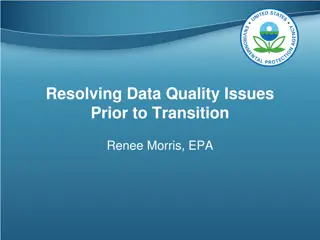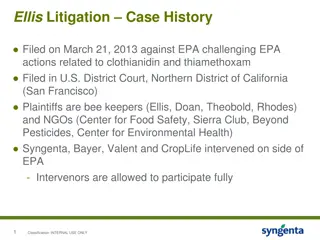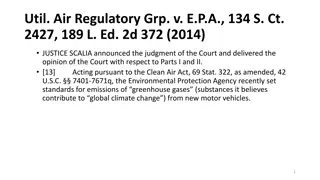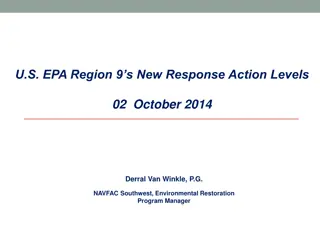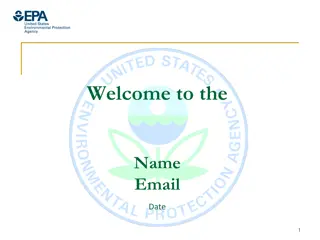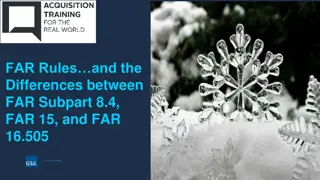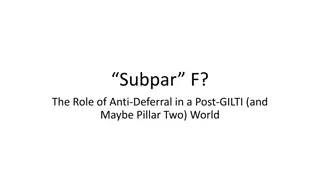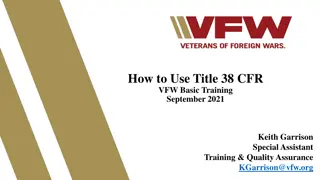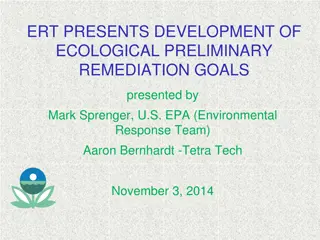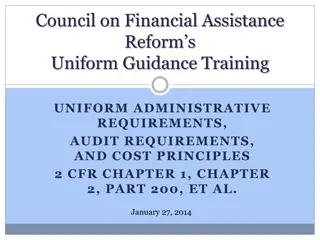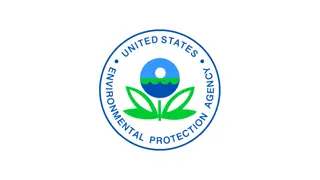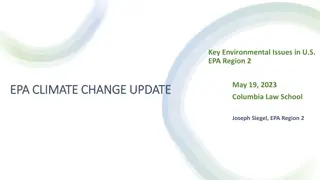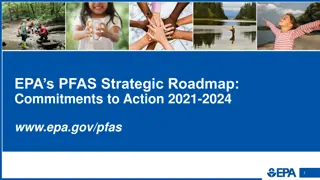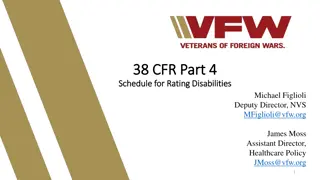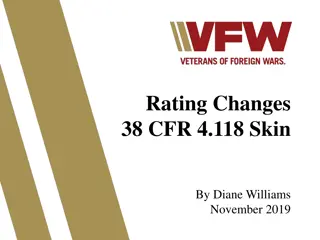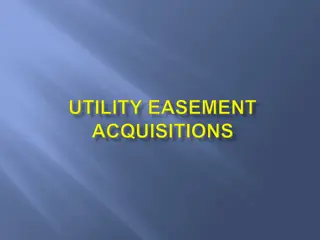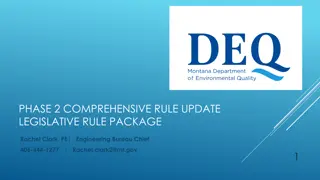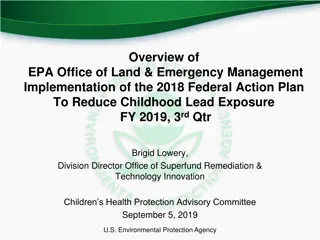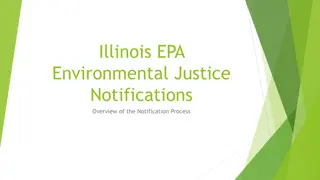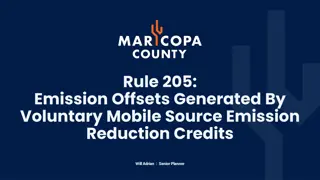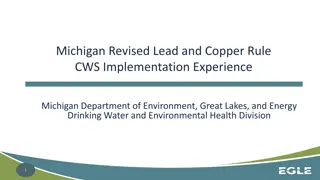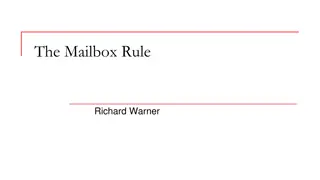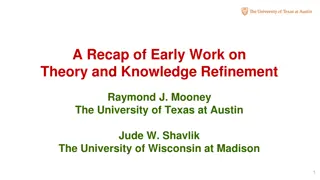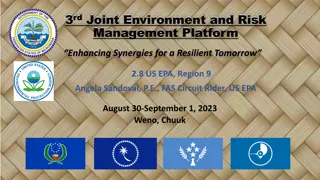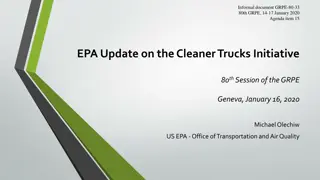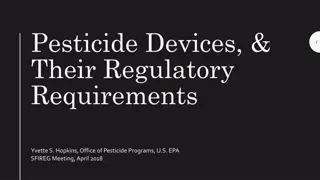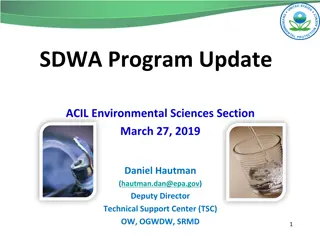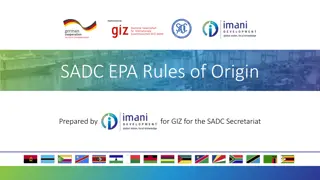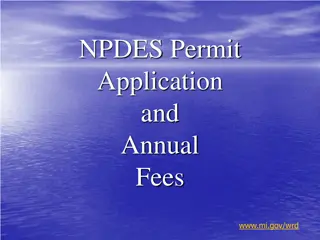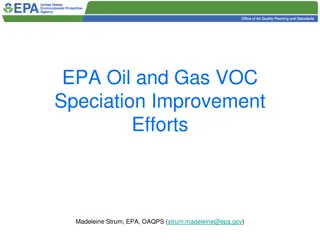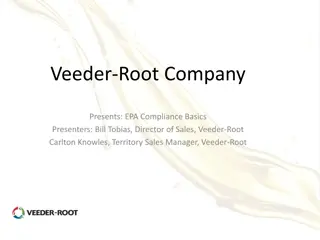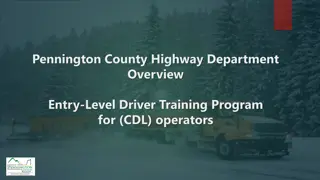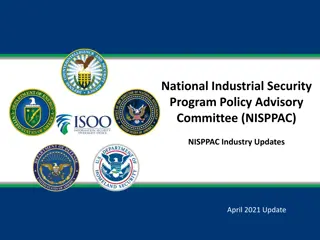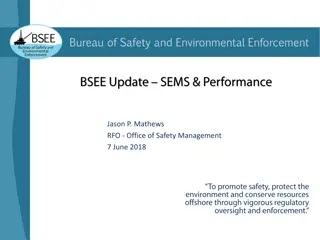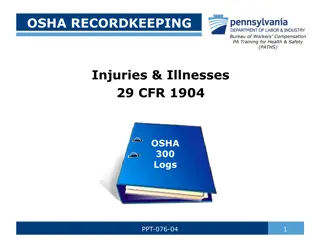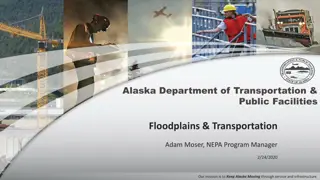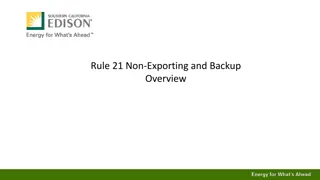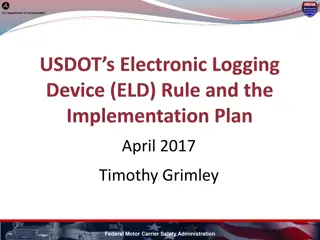EPA Rule 40 CFR Part 63 Subpart HHHHHH Overview
EPA Rule 40 CFR Part 63 Subpart HHHHHH, also known as The Refinisher Rule, sets standards for hazardous air pollutants in paint stripping and surface coatings operations. The rule aims to control emissions of target hazardous air pollutants in collision centers and surrounding areas. It outlines requirements for compliance, training, notification, and record-keeping, providing materials for owners/managers to ensure EPA Rule compliance.
- EPA Rule Compliance
- Hazardous Air Pollutants
- Collision Centers
- Surface Coatings
- Environmental Regulation
Download Presentation

Please find below an Image/Link to download the presentation.
The content on the website is provided AS IS for your information and personal use only. It may not be sold, licensed, or shared on other websites without obtaining consent from the author. Download presentation by click this link. If you encounter any issues during the download, it is possible that the publisher has removed the file from their server.
E N D
Presentation Transcript
National Emissions Standard for Hazardous Air Pollutants: Paint Stripping and Miscellaneous Surface Coatings Operations at Area Sources Overview and Training EPA Rule 40 CFR Part 63 Subpart HHHHHH The Refinisher Rule Sensitivity: Business Internal Sensitivity: Business Internal
Contents Section One Overview and Resources: Purpose Rule Overview and Training Requirements Coatings covered by the Rule Compliance dates Spray Area Requirements and Booth/Filter Maintenance Equipment: what is covered and not covered Notification and Record-keeping requirements for Shops Resources Section Two Paint Technician Training: Training Objectives Spray Training for Paint Technicians Maximizing paint efficiency: Tools for getting the most from your paint Post-Training Review 2 2 PROPRIETARY Sensitivity: Business Internal Sensitivity: Business Internal
Section One Objectives and Overview 3 PROPRIETARY Sensitivity: Business Internal Sensitivity: Business Internal
Environmental Regulatory Update and Training Purpose of this presentation: Provide overview of EPA Rule 40 CFR Part 63 Subpart HHHHHH requirements for Surface Coatings Operations at Area Sources Provide materials for Collision Center owners/managers as part of their overall documentation of compliance with EPA Rule 40 CFR Part 63 Subpart HHHHHH Provide specific training components for Paint Technicians 4 4 PROPRIETARY Sensitivity: Business Internal Sensitivity: Business Internal
Whats in a name? EPA Rule 40 CFR Part 63 Subpart HHHHHH Known by many names: The Refinisher Rule Rule 40 6H Subpart HHHHHH NESHAP NESHAPs National Area Source Rule Refinish Area Source Rule and probably a few others All refer to the same EPA Rule 5 5 PROPRIETARY Sensitivity: Business Internal Sensitivity: Business Internal
EPA Rule 40 CFR Part 63 Subpart HHHHHH Overview: HAPs Regulation In January 2008, the US EPA published the National Emissions Standards for Hazardous Air Pollutants: Paint Stripping and Miscellaneous Surface Coatings Operations at Area Sources. EPA established this Rule to control the emissions of target HAPs in the collision center environment and surrounding community. Four basic requirements for Collision Centers: 1. Initial Notification of EPA by Collision Center (due in 2010) 2. Compliance and notification by Collision Center (due not later than 2011) 3. Training of paint spraying personnel 4. Record-keeping by Collision Center 6 6 PROPRIETARY Sensitivity: Business Internal Sensitivity: Business Internal
EPA Rule 40 CFR Part 63 Subpart HHHHHH This EPA Rule covers two primary operations: Paint Stripping Operations Spray Coatings Operations 7 7 PROPRIETARY Sensitivity: Business Internal Sensitivity: Business Internal
EPA Rule 40 CFR Part 63 Subpart HHHHHH Paint Stripping Paint stripping operations using Methylene Chloride (MeCl) for the partial or complete removal of surface coatings from wood, metal or plastic substances are subject to this EPA Rule Requirements for MeCl paint stripping operations: 1. Optimization of stripper application 2. Proper storage and disposal of MeCl bearing material 3. MeCl Minimization Plan for use greater than 1 ton per year What the Collision Center must do: 1. Identify methods of paint stripping used and the substrates stripped 2. Include method and substrate information on initial Notification to EPA 3. Indicate on Notification if Collision Center plans annual use of MeCl exceeding 1 ton 8 8 PROPRIETARY Sensitivity: Business Internal Sensitivity: Business Internal
EPA Rule 40 CFR Part 63 Subpart HHHHHH Surface Coating Motor Vehicle and Mobile Equipment Surface Coating Operations involve spray application of coatings at area sources to automobiles, light trucks, heavy duty trucks, buses, construction equipment, self-propelled vehicles and equipment that may be drawn and/or driven on a highway Miscellaneous Surface Coating Operations involve the spray application of coatings that contain compounds of target HAPs to miscellaneous parts and/or products made of metal or plastic, or combinations of metal and plastic Requirements: 1. HVLP, Electrostatic, Airless, Air assisted Airless spray guns or a gun with demonstrated equivalency of transfer efficiency of HVLP 2. all spray application of coatings in a prep station or spray booth 3. booth exhaust filters must have demonstrated filter efficiency of 98% 4. enclosed gun cleaner or disassembled cleaning 5. spray painter training 9 9 PROPRIETARY Sensitivity: Business Internal Sensitivity: Business Internal
EPA Rule 40 CFR Part 63 Subpart HHHHHH Requires Paint Technicians to be trained on: The general provisions of the Rule Roles requiring training Coatings covered by this Rule Compliance dates Spray Areas and equipment requirements in the Shop Spray Gun Requirements 1. Spray Gun Set-Up for best transfer efficiency 2. Spray Gun Operation for best transfer efficiency 3. Spray techniques to improve transfer efficiency 4. Spray gun cleaning 10 10 PROPRIETARY Sensitivity: Business Internal Sensitivity: Business Internal
Training is required for: All painters who work on motor vehicles and mobile equipment surface coatings operations that involve the spray application of coatings at area sources to: Automobiles Light trucks Heavy duty trucks Buses Construction Equipment Self-propelled vehicles Any equipment that may be drawn and/or driven on a roadway Also applies to painters who spray apply HAP- containing coatings to miscellaneous metal parts 11 11 PROPRIETARY Sensitivity: Business Internal Sensitivity: Business Internal
Training is also required for Painters who spray apply target HAP-containing coatings to miscellaneous metal parts. Target HAPs are: Chromium (Cr) Lead (Pb) Manganese (Mn) Nickel (Ni) Cadmium (Cd) All shops could have a number of colors and/or primers with one or more of the targeted HAPs. Consult product MSDS. Shop can petition EPA (in initial notification) if it can prove that all coatings being used do not contain any target HAPs. This petition does not guarantee exemption. 12 12 PROPRIETARY Sensitivity: Business Internal Sensitivity: Business Internal
Compliance dates As of January 9, 2008: New shops (shops that have begun spraying since 9/17/2007) must comply immediately Existing shops must have complied by January 10, 2011 Painters must be trained within the next two years Training will be good for 5 years, and refresher must be repeated every 5 years All spray painters at new sources (new shop employment location) must complete training no later than 180 days after hiring All painters must have a certificate to show date of training Shops must notify EPA that they are subject to Rule by 01/11/2010 (initial notification), and submit notification of compliance status by 3/11/2011 13 13 PROPRIETARY Sensitivity: Business Internal Sensitivity: Business Internal
Spray Area All spray-applied coatings must be used in a prep station or spray booth Prep stations and spray booths large enough to fit a vehicle must have four side walls or curtains and a full roof Parts must be sprayed in a booth with at least three side walls or curtains and a full roof Booth and prep station filters must achieve 98% filter efficiency of overspray 14 14 PROPRIETARY Sensitivity: Business Internal Sensitivity: Business Internal
Booth Filters Booth filters improve job quality and protect environment Allow air to flow evenly Captures overspray, decreases emissions Rule Requirement: 98% or greater efficiency for exhaust filters Establish and document filter change-out schedule and procedure Maintain documentation from filter manufacturer that filters are 98% efficient 15 15 PROPRIETARY Sensitivity: Business Internal Sensitivity: Business Internal
Approved Equipment HVLP (defined as 65% Transfer Efficient (TE) and 10 psi at cap) Electrostatic spray guns Airless spray guns Air Assisted spray guns Any non-HVLP gun demonstrated to achieve 65% TE with manufacturer documentation Check local regulations if local laws are more strict, they may over-rule national laws All motor vehicle and mobile equipment spray coating operations and miscellaneous surface coating operations with a cup size larger than 3.0 ounces or 89cc must comply with this Rule 16 16 PROPRIETARY Sensitivity: Business Internal Sensitivity: Business Internal
Activities Exempted from Rule Spray applications using a hand-held device with cup capacity no more than 3 fluid ounces (89cc) Powder coating Hand-held, non-refillable aerosol containers Non-atomizing technology Thermal spray operations using solid metallic or non-metallic materials 17 17 PROPRIETARY Sensitivity: Business Internal Sensitivity: Business Internal
Notification and Record-keeping Requirements Notifications: Initial notification to EPA or delegated state agency that Collision Center is subject to the rule that is, that the Collision Center is an area source 1. New Source w/in 180 days after start-up or publication of final rule, whichever is later 2. Existing Source 1 year before compliance date: January 9, 2010 Notification of compliance status to EPA or delegated state agency 1. New Source 180 days after compliance date for the facility 2. Existing Source 30 days after compliance date for the facility (30 days after January 9, 2011) States or local authorities may have more strict rules. Check your local authorities for any other rules. 18 18 PROPRIETARY Sensitivity: Business Internal Sensitivity: Business Internal
Notification and Record-keeping Requirements Recordkeeping by the Collision Center*: Copies of Notifications submitted to EPA Painter training certifications Spray booth filter efficiency documentation Spray gun transfer efficiency MeCl content information such as MSDS Annual usage of MeCl for paint stripping, and written MeCl minimization plan if annual usage > 1 ton per year Deviation and corrective action documentation *Records to be maintained in a form suitable and readily available for expeditious review by EPA 19 PROPRIETARY Sensitivity: Business Internal Sensitivity: Business Internal
Resources For more information on EPA Rule 40 CFR Part 63 Subpart HHHHHH go to: www.epa.gov/ttn/atw/area/fr09ja08.pdf www.epa.gov/collision-repair-campaign www.epa.gov/ttn/atw/area/autobodybs.doc www.epa.gov/ttn/atw/area/arearules.html For a video overview of the Rule (English and Spanish) and for more information on Axalta products and recommendations go to: https://www.epa.gov/collision-repair-campaign/outreach- materials-collision-repair-campaign 20 20 PROPRIETARY Sensitivity: Business Internal Sensitivity: Business Internal



